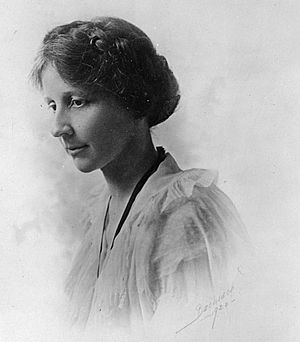Eunice Rockwood Oberly facts for kids
Quick facts for kids
Eunice Rockwood Oberly
|
|
|---|---|
 |
|
| Born | March 7, 1878 Cairo |
| Died | November 5, 1921 |
| Occupation | Librarian, bibliographer |
| Employer |
|
Eunice Rockwood Oberly (born March 7, 1878 – died November 5, 1921) was an important librarian. She worked for the United States Department of Agriculture for her entire career. She is best known for being the librarian of the Bureau of Plant Industry. She also created a helpful guide called the Check List of Publication of the State Agricultural Experiment Stations on the Subject of Plant Pathology 1876-1920.
Contents
Early Life and Education
Eunice R. Oberly was born on March 7, 1878, in Cairo, Illinois. She was the youngest of seven daughters. Her father, John H. Oberly, was the editor of a newspaper called the "Cairo Bulletin."
In 1885, her family moved to Washington, D.C. Her father started a new job as a Civil Service Commissioner. Later, he became the Commissioner of Indian Affairs under President Grover Cleveland.
Eunice went to public schools in Washington, D.C. She then went on to graduate from Vassar College in June 1900. While at Vassar, she was the historian for her class.
A Career in Libraries
Eunice Oberly started her career at the United States Department of Agriculture. She began by doing "bibliographical work" in the Division of Animal Industry. This means she helped organize and list books and articles.
Later, she became the librarian for the Division of Vegetable Physiology and Pathology. In 1908, several smaller libraries joined together. They formed the library of the Bureau of Plant Industry. Eunice Oberly was chosen to be its librarian.
Helping Researchers Find Information
The Bureau of Plant Industry Library focused on helping scientists. It didn't just collect books. Instead, it worked on indexing and cataloging plant-related writings. This made it easier for researchers to find information.
The library helped scientists get materials from other big libraries. These included the Library of Congress and the United States National Agricultural Library. Eunice wanted to make information from libraries all over the country easy to find.
To do this, she started writing lists of plant diseases. These lists were printed in a journal called Phytopathology starting in 1914. Her team continued this work even after she passed away.
She also created a special list of botanical literature. This list included full details of important plant-related writings. It was sent out every two weeks to anyone who asked for it.
Important Publications
Eunice Oberly also created two publications called "Bibliographical Contributions." These were published by the Department of Agriculture Library.
The first one came out in 1918. It was called Bibliographical Contributions Number 1: Check list of Publications of the Department of Agriculture on the Subject of Plant Pathology.
She then started working on Biographical Contributions Number 2. This guide listed publications from State Agricultural Experiment Stations. It covered plant pathology from 1876 to 1920. Her assistant, Jessie M. Allen, finished and published it in 1922. This was a year after Eunice's death.
Eunice also wrote about making scientific libraries better. She wanted to improve how scientific information was written.
Active Outside of Work
Outside of her library work, Eunice Oberly was very active in Washington, D.C. She was the president of the Vassar Alumnae association in the D.C. area. She also joined the American Library Association in 1906.
She became known for her efforts during World War I. She helped get ambulances to France. She was also an organizer for the Woman Suffrage Council in D.C. This group worked to get women the right to vote.
Lasting Impact
Eunice R. Oberly died suddenly on November 5, 1921, at her home in Washington, D.C. She was 43 years old.
After her death, her friends wanted to honor her memory. In 1923, they donated $800 to the American Library Association. This money was used to create an annual award. The award would go to the person who created the best bibliography (list of books/articles) in natural sciences or agriculture each year.
The American Library Association accepted the donation. They invested the money to make sure the award could continue. A committee was set up to manage it. This award is still given out every two years today. It is called the STS Oberly Award for Bibliography in the Agricultural or Natural Sciences.
Images for kids


